Science: AI competition, academia loses
In the field of AI, the focus has shifted from academia to industry, and the imbalance continues.
Science published an article in the latest issue of the official issue, which compiled relevant data in the field of AI in recent years. The results are also clear at a glance:
AI competition, academic circles lose .
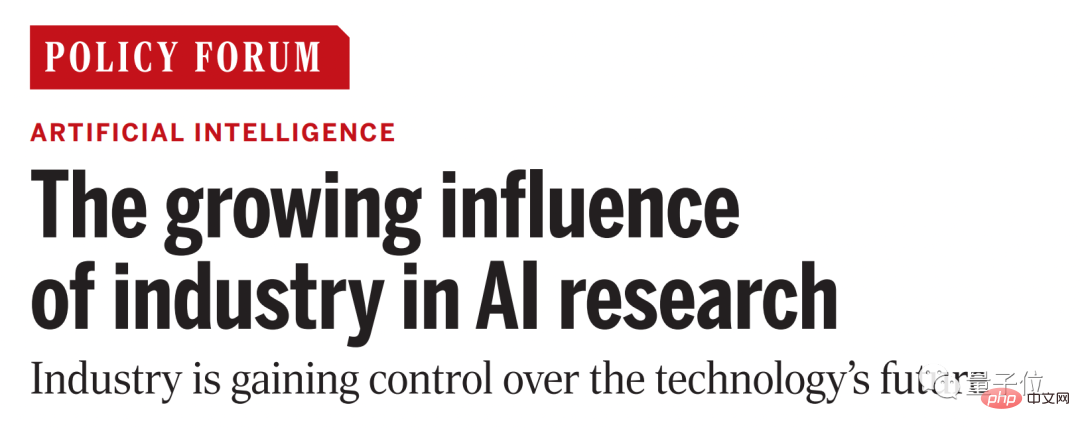
Science counts the proportion of papers, AI largest models, and SOTA models in various fields.
Since 2016, the proportion of papers published by the industry at leading artificial intelligence conferences has started a trend of brutal growth.
In 4 years, the industry has "taken" almost 20% from the academia in terms of the number of papers.

The top 10 models in the AI field were still dominated by academia before 2013.
After that, the industry continued to exert its efforts. By 2016, almost all of the next 10 major AI models came from the industry.

Not to mention the SOTA model. Last year, the industry directly dominated the SOTA of language models and image classification,
The SOTA that analyzes emotion, semantic segmentation and target detection is roughly half the work of industry and academia, while the SOTA of machine translation all comes from academia.
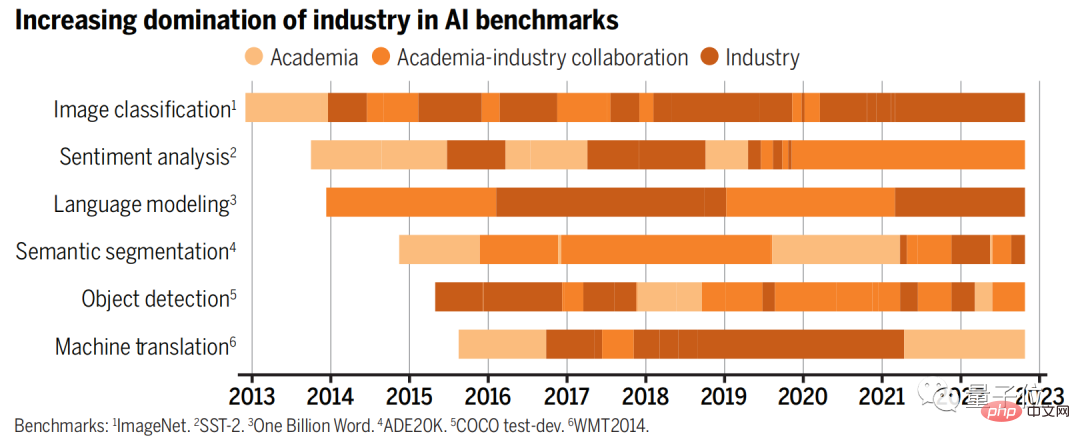
Of course, this trend is also a tacit fact in the hearts of netizens, and some people even made meme pictures to ridicule:

There is a heavy brain drain in academia
The most important reason for the current situation is:
talent loss.
Taking data from North American universities as an example, computer Ph.D.s specializing in AI research are currently pouring into the industry:
In 2004, only 21% of Ph.D.s chose to enter the industry. By 2020 , the proportion of PhDs entering the industry has reached nearly 70%.
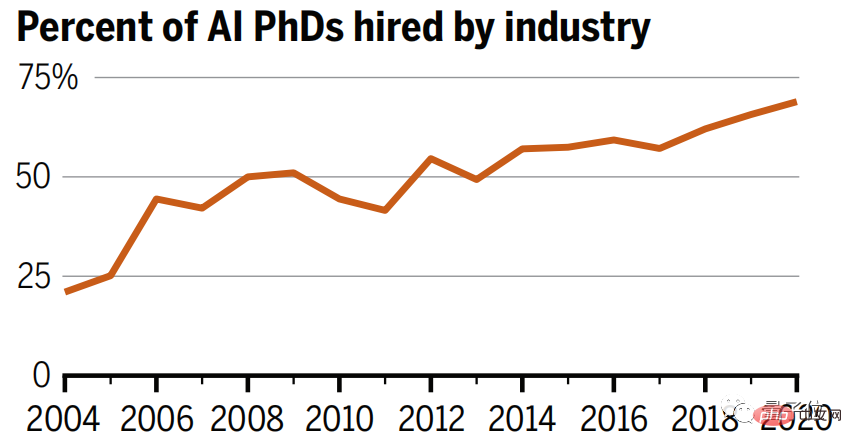
Moreover, this data is limited to talents in the field of AI research.
It can be seen from the data in recent years that the industrial demand for general computer science has not changed significantly. On the contrary, the market demand for talents specializing in the field of AI has increased eightfold since 2006.
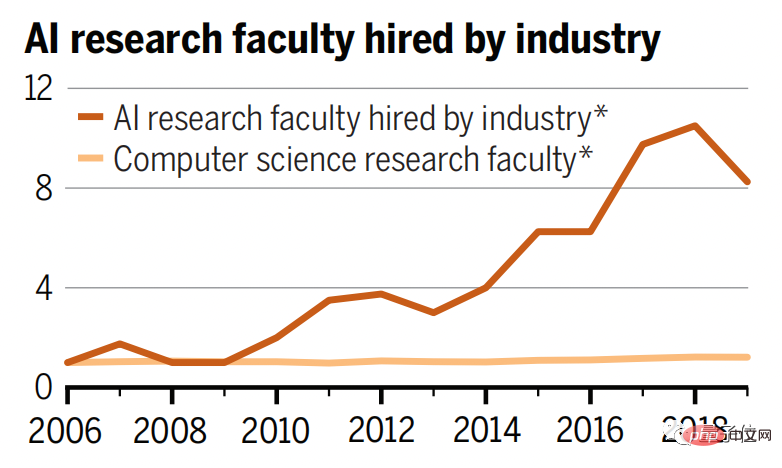
So why are AI talents flowing from academia to industry?
From a large level, it is related to the computing power mentioned before by Science.
Obviously, the industry has a great advantage over academia in this area.
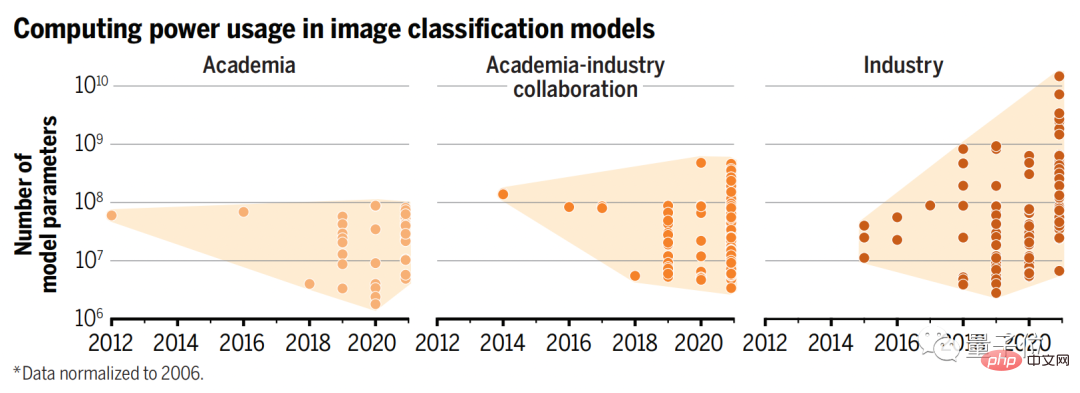
If a worker wants to do his job well, he must first sharpen his tools. Whoever has strong computing power will naturally be able to attract more talents.
But to put it bluntly, whether the computing power is strong or not depends largely on capital investment.
Give a chestnut
The source of scientific research funds in academia mainly comes from government support. In 2021, the investment by relevant US departments in artificial intelligence is 1.5 billion US dollars, and the EU's investment in the same year is 1.2 billion. Dollar.In contrast, the global AI industry’s expenditure this year has exceeded 340 billion US dollars. Even in 2019, Alphabet, Google’s parent company, invested US$1.5 billion in its subsidiary DeepMind.
Of course, the above are all discussed from a relatively macro perspective, so how do individual researchers as individual think about it?
Researcher Rowan Zellers, who just joined OpenAI after graduating from his Ph.D., showed up and gave his own account.
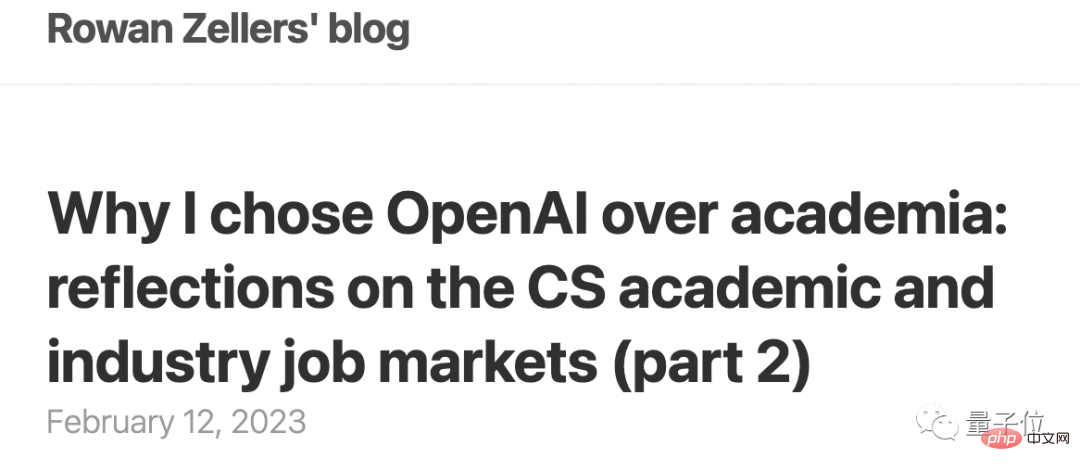
Rowan Zellers bluntly said that he was torn between industry and academia when choosing employment, but in the end he chose industry. And the reasons, he also listed them one by one:
- It will become increasingly difficult for academia to conduct groundbreaking system construction research
- The cost of scientific research in the field of AI is increasing exponentially
- Academia’s shift to applied research is The general trend
......
From basic research to application, the industry has it all
And the loss of talent and the tilt of computing power can also be said to be the inevitable result to a certain extent , in the Science article, two reasons are listed:
- The AI field is unique compared to other subject areas;
- The industry pays more attention to technology commercialization.
Let’s first talk about this particularity in the AI field.
In other subject areas, academia and industry will naturally form a division of labor. Basic research is completed by universities, and applied research and development are the work of industry.
However, this set of logic does not apply to the AI circle. In the field of AI, the boundaries between basic research and applied research are blurred.
In other words, there is overlap between application models used in industry and basic research. Take the Transformer model developed by Google Brain in 2017 as an example. It not only belongs to basic research, but can also be further used. directly used in industry.
In addition, the increased investment in artificial intelligence by the industry may lead to the commercialization of technology, which will not only provide substantial benefits to society, but also provide rewards for the industry itself. .
As for academia, the majority of funding sources depend on allocations from relevant institutions.
For AI talents who stay in school, although they can get bonuses and get promoted for publishing papers, scientific research is not their only job. They also have teaching tasks.
And generally speaking, academic research laboratories are non-profit. For example, Rowan Zellers worked at the Allen Institute for Artificial Intelligence before joining OpenAI: it took a lot of time and money. . .
emmmmm, it seems that the academic community has completely lost in this AI competition.
One More Thing
Of course, it cannot be said that the academic community has completely lost the AI competition. In the top 100 paper citations ranked by Zeta Alpha statistics, there is still a balance between academia and industry. Very good.
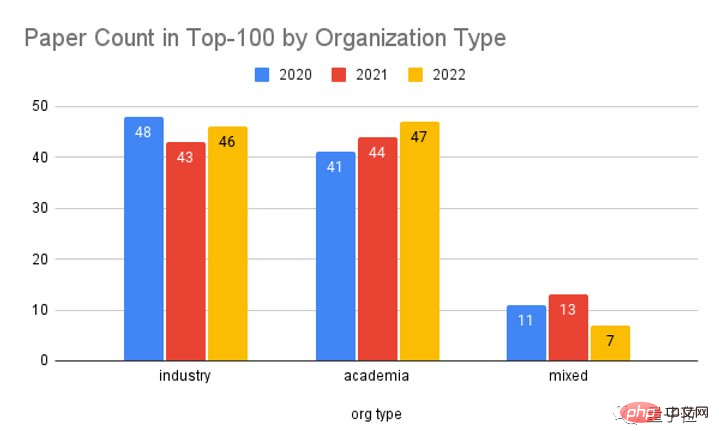
△Picture source: Zeta Alpha
Speaking of which, what do you think of the AI competition between academia and industry?
Reference link:
[1]https://www.php.cn/link/f812291e86e5d515984dc44cf9d41ac3
[2]https://www.php.cn/link/6a21bd02b3d17059c61bcb2eeb48b8cd
[3]https://www.php.cn/link/32b9e74c8f60958158eba8d1fa372971
The above is the detailed content of Science: AI competition, academia loses. For more information, please follow other related articles on the PHP Chinese website!

Hot AI Tools

Undresser.AI Undress
AI-powered app for creating realistic nude photos

AI Clothes Remover
Online AI tool for removing clothes from photos.

Undress AI Tool
Undress images for free

Clothoff.io
AI clothes remover

Video Face Swap
Swap faces in any video effortlessly with our completely free AI face swap tool!

Hot Article

Hot Tools

Notepad++7.3.1
Easy-to-use and free code editor

SublimeText3 Chinese version
Chinese version, very easy to use

Zend Studio 13.0.1
Powerful PHP integrated development environment

Dreamweaver CS6
Visual web development tools

SublimeText3 Mac version
God-level code editing software (SublimeText3)

Hot Topics
 1653
1653
 14
14
 1413
1413
 52
52
 1304
1304
 25
25
 1251
1251
 29
29
 1224
1224
 24
24
 Recommended reliable digital currency trading platforms. Top 10 digital currency exchanges in the world. 2025
Apr 28, 2025 pm 04:30 PM
Recommended reliable digital currency trading platforms. Top 10 digital currency exchanges in the world. 2025
Apr 28, 2025 pm 04:30 PM
Recommended reliable digital currency trading platforms: 1. OKX, 2. Binance, 3. Coinbase, 4. Kraken, 5. Huobi, 6. KuCoin, 7. Bitfinex, 8. Gemini, 9. Bitstamp, 10. Poloniex, these platforms are known for their security, user experience and diverse functions, suitable for users at different levels of digital currency transactions
 Which of the top ten currency trading platforms in the world are the latest version of the top ten currency trading platforms
Apr 28, 2025 pm 08:09 PM
Which of the top ten currency trading platforms in the world are the latest version of the top ten currency trading platforms
Apr 28, 2025 pm 08:09 PM
The top ten cryptocurrency trading platforms in the world include Binance, OKX, Gate.io, Coinbase, Kraken, Huobi Global, Bitfinex, Bittrex, KuCoin and Poloniex, all of which provide a variety of trading methods and powerful security measures.
 What are the top ten virtual currency trading apps? The latest digital currency exchange rankings
Apr 28, 2025 pm 08:03 PM
What are the top ten virtual currency trading apps? The latest digital currency exchange rankings
Apr 28, 2025 pm 08:03 PM
The top ten digital currency exchanges such as Binance, OKX, gate.io have improved their systems, efficient diversified transactions and strict security measures.
 What are the top currency trading platforms? The top 10 latest virtual currency exchanges
Apr 28, 2025 pm 08:06 PM
What are the top currency trading platforms? The top 10 latest virtual currency exchanges
Apr 28, 2025 pm 08:06 PM
Currently ranked among the top ten virtual currency exchanges: 1. Binance, 2. OKX, 3. Gate.io, 4. Coin library, 5. Siren, 6. Huobi Global Station, 7. Bybit, 8. Kucoin, 9. Bitcoin, 10. bit stamp.
 How much is Bitcoin worth
Apr 28, 2025 pm 07:42 PM
How much is Bitcoin worth
Apr 28, 2025 pm 07:42 PM
Bitcoin’s price ranges from $20,000 to $30,000. 1. Bitcoin’s price has fluctuated dramatically since 2009, reaching nearly $20,000 in 2017 and nearly $60,000 in 2021. 2. Prices are affected by factors such as market demand, supply, and macroeconomic environment. 3. Get real-time prices through exchanges, mobile apps and websites. 4. Bitcoin price is highly volatile, driven by market sentiment and external factors. 5. It has a certain relationship with traditional financial markets and is affected by global stock markets, the strength of the US dollar, etc. 6. The long-term trend is bullish, but risks need to be assessed with caution.
 Which of the top ten currency trading platforms in the world are among the top ten currency trading platforms in 2025
Apr 28, 2025 pm 08:12 PM
Which of the top ten currency trading platforms in the world are among the top ten currency trading platforms in 2025
Apr 28, 2025 pm 08:12 PM
The top ten cryptocurrency exchanges in the world in 2025 include Binance, OKX, Gate.io, Coinbase, Kraken, Huobi, Bitfinex, KuCoin, Bittrex and Poloniex, all of which are known for their high trading volume and security.
 How to measure thread performance in C?
Apr 28, 2025 pm 10:21 PM
How to measure thread performance in C?
Apr 28, 2025 pm 10:21 PM
Measuring thread performance in C can use the timing tools, performance analysis tools, and custom timers in the standard library. 1. Use the library to measure execution time. 2. Use gprof for performance analysis. The steps include adding the -pg option during compilation, running the program to generate a gmon.out file, and generating a performance report. 3. Use Valgrind's Callgrind module to perform more detailed analysis. The steps include running the program to generate the callgrind.out file and viewing the results using kcachegrind. 4. Custom timers can flexibly measure the execution time of a specific code segment. These methods help to fully understand thread performance and optimize code.
 Decryption Gate.io Strategy Upgrade: How to Redefine Crypto Asset Management in MeMebox 2.0?
Apr 28, 2025 pm 03:33 PM
Decryption Gate.io Strategy Upgrade: How to Redefine Crypto Asset Management in MeMebox 2.0?
Apr 28, 2025 pm 03:33 PM
MeMebox 2.0 redefines crypto asset management through innovative architecture and performance breakthroughs. 1) It solves three major pain points: asset silos, income decay and paradox of security and convenience. 2) Through intelligent asset hubs, dynamic risk management and return enhancement engines, cross-chain transfer speed, average yield rate and security incident response speed are improved. 3) Provide users with asset visualization, policy automation and governance integration, realizing user value reconstruction. 4) Through ecological collaboration and compliance innovation, the overall effectiveness of the platform has been enhanced. 5) In the future, smart contract insurance pools, forecast market integration and AI-driven asset allocation will be launched to continue to lead the development of the industry.




